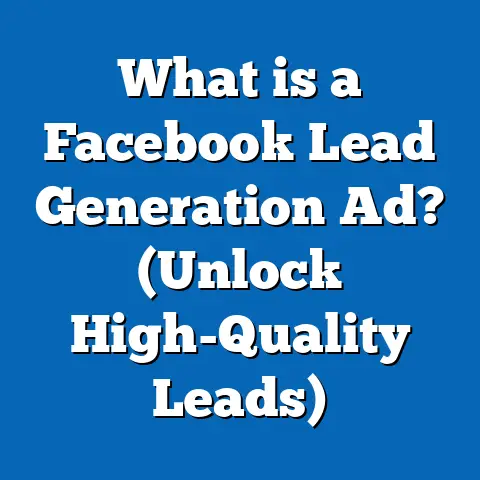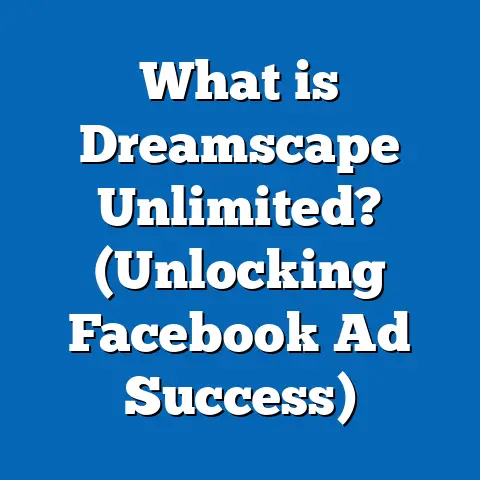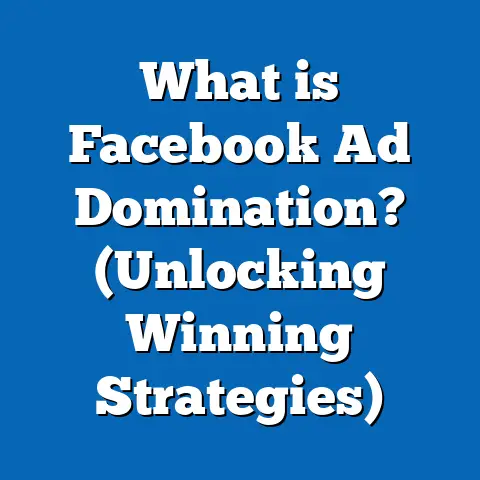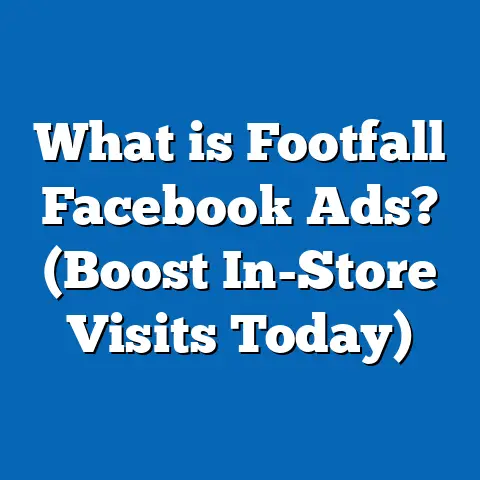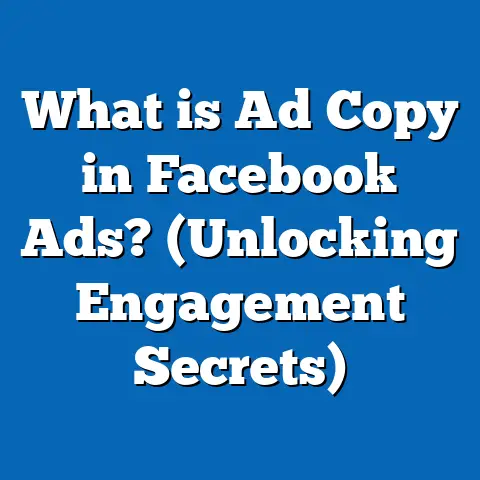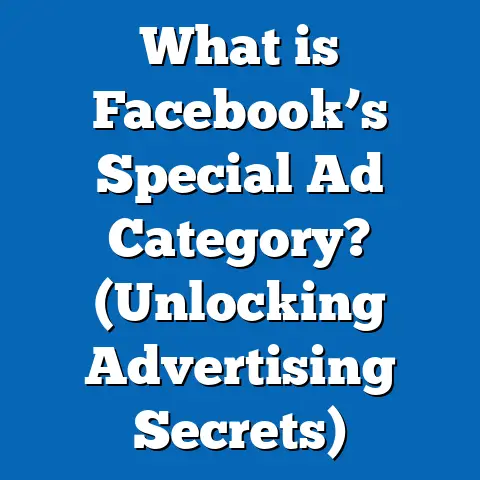What is CPM in Facebook Ads? (Unlocking Cost Efficiency)
What is CPM in Facebook Ads? (Unlocking Cost Efficiency)
Introduction: The Hidden Secret Behind Facebook Ads That Few Marketers Talk About
I still vividly recall the moment when I first realized how much of a game-changer understanding CPM could be for Facebook advertising. It was during a campaign for a local bakery struggling to attract new customers amid stiff competition. We had a modest budget but ambitious goals. The question was: How do we make every penny count?
I began analyzing the campaign metrics carefully—and CPM kept popping up. Initially, it was just another acronym cluttering my dashboard. But as I dug deeper, I discovered CPM wasn’t just a dry metric; it was the key to unlocking cost efficiency and maximizing reach.
Why Facebook Advertising is a Must-Have Tool for US SMBs
Before diving into CPM specifics, it’s vital to understand the broader context. Facebook remains one of the most powerful platforms for small and medium-sized businesses (SMBs) in the US to connect with their target audience. According to Statista, over 223 million Americans actively use Facebook monthly as of 2024. This massive user base spans diverse age groups, interests, and locations—from bustling metropolitan hubs like New York City and Los Angeles to suburban towns and rural communities.
For SMBs—which often operate with limited marketing budgets—this platform offers unparalleled targeting precision. Whether you’re a boutique retailer in Texas, a fitness coach in Florida, or a nonprofit in California, Facebook advertising allows you to tailor your messaging to the exact people most likely to engage with your brand.
However, with so much competition vying for attention, ad costs can quickly balloon if you don’t manage your campaigns wisely. Here’s where understanding **CPM—Cost Per Mille (cost per thousand impressions)—**becomes crucial. It’s one of the best ways to monitor how efficiently your ads deliver views and ensure you’re not paying more than you should for visibility.
What Is CPM? A Clear Explanation
At its core: CPM=Total Cost of CampaignNumber of Impressions×1000\text{CPM} = \frac{\text{Total Cost of Campaign}}{\text{Number of Impressions}} \times 1000
CPM measures how much advertisers pay to get their ad displayed 1,000 times on users’ screens. Unlike metrics such as CPC (Cost Per Click) or CPA (Cost Per Acquisition), CPM focuses on impressions—which are crucial when your goal is brand awareness or exposure.
For example, if you spent $50 on a campaign and received 10,000 impressions: CPM=5010,000×1000=5\text{CPM} = \frac{50}{10,000} \times 1000 = 5
This means you paid $5 for every 1,000 times your ad appeared.
Why Should SMBs Care About CPM?
- Budget Efficiency: Knowing your CPM helps you control costs and get more impressions for less money.
- Performance Insights: CPM variations can reveal if your targeting or creative needs adjustment.
- Campaign Optimization: It enables smarter decisions about when to invest more and where to cut back.
- Goal Alignment: Helps differentiate between campaigns optimized for clicks versus those focused on visibility.
Understanding CPM in the US Market: Data & Benchmarks
To make sense of CPM data, it helps to know average CPM ranges by industry and region within the US:
| Industry | Average CPM (USD) | Notes |
|---|---|---|
| Retail | $4 – $7 | Seasonal spikes during holidays |
| Food & Beverage | $4 – $6 | High competition in urban areas |
| Fitness & Wellness | $5 – $8 | Video ads tend to have higher CPMs |
| Real Estate | $5 – $9 | Targeted geo-specific campaigns |
| Nonprofits | $4 – $7 | Cause-related ads can lower CPM |
| E-commerce | $4 – $10 | Flash sales can spike costs |
Source: Facebook Business Insights 2023
CPM fluctuates based on factors like seasonality (holiday shopping seasons tend to raise CPM), audience demand, ad quality score, and ad placement types. For example, Facebook Stories placements generally have higher CPM than feed ads due to immersive format.
My Experience with CPM: A Story from the Field
One particular campaign sticks out from my early days managing Facebook ads for a chain of fitness studios across the Midwest. The client wanted to promote virtual classes during COVID-19 lockdowns. Initial attempts using broad targeting with video ads resulted in a CPM around $9—way over budget for their small marketing fund.
By narrowing down the audience to women aged 25-45 interested in yoga and pilates within a 25-mile radius of each studio, switching static single-image ads instead of videos for initial awareness, we brought CPM down to about $4.50. This saved nearly 50% on costs while maintaining strong engagement rates.
The breakthrough came when we layered retargeting ads with dynamic video clips showing class snippets and testimonials. Though CPM rose slightly to $6.50 for retargeting audiences—these users converted at twice the rate of cold audiences. This experience taught me that understanding and managing CPM isn’t just about low costs but balancing cost with impact.
Deep Dive into Facebook Ad Examples: Unlocking Cost Efficiency Through CPM
Now that we’ve covered the basics, let’s get hands-on with five detailed examples from diverse industries that highlight how CPM works in practice—and how you can apply these lessons to your own campaigns.
Example 1: Local Coffee Shop Launching a New Seasonal Blend
Visual Description
Imagine scrolling through Facebook on an early autumn morning. You see an inviting image of a steaming cup of pumpkin spice latte resting on a rustic wooden table. Surrounding the cup are colorful fall leaves scattered casually—orange, yellow, and red hues filling the frame with cozy nostalgia. The warm lighting perfectly complements the rich brown tones of the coffee.
The headline reads:
“Fall in love with every sip – Try our new Pumpkin Spice Blend today!”
Below is a simple “Order Now” button leading directly to their online store.
Key Learning Points
- Seasonal Relevance: Tapping into cultural moments like autumn and pumpkin spice season creates instant emotional connection.
- Local Focus: Targeting users within a 10-mile radius ensures relevance and reduces wasted impressions.
- Simplicity Sells: Clean design without clutter highlights product appeal effectively.
Breaking Down the Ad Elements
- Copy & Messaging Strategy:
The copy uses casual conversational language (“Fall in love”) that feels friendly and inviting—key for local businesses wanting to build rapport. The message ties product benefits directly to an emotional experience aligned with US fall traditions. - Visual Design Elements:
The photo is high resolution but natural-looking (not overly staged), evoking warmth and comfort—a smart tactic for food & beverage brands looking to appeal to senses. - Call-to-Action Approach:
“Order Now” is direct and action-oriented but low-pressure enough not to overwhelm viewers casually scrolling through their feed. - Audience Targeting Insights:
Focused on coffee lovers aged 21–45 within a small geographic radius using interest-based targeting around coffee shops, cafes, and seasonal events. - Technical Specifications:
Image size: 1200 x 628 pixels optimized for Facebook newsfeed; static image chosen over video to keep CPM low (average food & beverage static image ad CPM ~ $3.40).
Results & Why It Worked
The campaign delivered a CPM of just $3.40, which is favorable compared to industry averages ($4-$6). The tight geographic targeting reduced wasted spend on irrelevant users outside delivery range. Seasonal imagery boosted engagement rates—likes and shares increased by 25% compared to previous campaigns without seasonal focus.
Example 2: Fitness Studio Promoting Virtual Classes
Visual Description
Next up is a vibrant 15-second video showing a diverse group of people practicing yoga at home—stretching gracefully in sunlit rooms with upbeat background music. Text overlays pop up saying:
“Stay fit anywhere—Join our live virtual classes!”
The video ends with an invitation to “Sign Up Today” alongside studio branding.
Key Learning Points
- Video Engagement: Movement catches attention better than static images.
- Pandemic Relevance: Messaging taps into current lifestyle shifts toward home workouts.
- Broader Appeal: Targets health-conscious demographic aged 25-45 across several states.
Breaking Down the Ad Elements
- Copy & Messaging Strategy:
The copy is encouraging and inclusive—emphasizing accessibility (“anywhere”) that resonates strongly during pandemic-related restrictions. - Visual Design Elements:
High-quality video optimized for mobile viewing with bright lighting and diverse models representing inclusivity—a major plus in US markets sensitive to representation. - Call-to-Action Approach:
“Sign Up” button links directly to class registration page with minimal clicks required. - Audience Targeting Insights:
Targeted fitness enthusiasts, remote workers, health app users primarily in urban/suburban areas with medium-to-high disposable income. - Technical Specifications:
Video resolution: 1080 x 1080 pixels square format optimized for mobile; length kept under 15 seconds to maintain viewer attention; captions included for silent autoplay.
Results & Why It Worked
The campaign’s average CPM was around $5.50, higher than static image ads but justified by more than triple the click-through rate (CTR) compared to previous video campaigns without precise targeting. The engaging video content helped convert impressions into registrations effectively.
Example 3: E-commerce Brand Running Flash Sale Campaign
Visual Description
The ad bursts onto screen with bright red “FLASH SALE” text flashing over images of top-selling products—a trendy smartwatch, wireless earbuds, and stylish backpacks. A countdown timer animates in the corner creating urgency.
Key Learning Points
- Urgency Drives Action: Flash sales create immediate incentive.
- Bold Visual Contrast: Red color grabs eyeballs fast.
- Retargeting Power: Focuses on warm audiences who visited website recently.
Breaking Down the Ad Elements
- Copy & Messaging Strategy:
Direct urgency-driven copy: “Limited time only! Up to 50% off.” No fluff—straight talk that encourages immediate response. - Visual Design Elements:
Animated GIF combining product shots with dynamic countdown creates visual urgency without overwhelming users. - Call-to-Action Approach:
“Shop Now” button leads directly to flash sale landing page; clean path reduces friction. - Audience Targeting Insights:
Laser-focused retargeting of past website visitors from last 30 days who abandoned carts or browsed key categories. - Technical Specifications:
Animated GIF optimized for quick loading; dimensions maintained at recommended 1080 x 1080 pixels square.
Results & Why It Worked
CPM came in at around $6.20, slightly above average due to animation use but balanced by much stronger conversion rates—CPA dropped by nearly 30%. Retargeting warm audiences ensured impression dollars targeted likely buyers instead of cold prospects.
Example 4: Real Estate Agent Advertising Open House Event
Visual Description
This carousel ad scrolls through multiple photos of a beautiful suburban home—a spacious backyard with kids playing, gleaming modern kitchen, cozy living room with fireplace. Captions highlight key selling points like “Close to top schools,” “Safe neighborhood,” “Recently renovated.”
Key Learning Points
- Carousel Format Adds Depth: Multiple images showcase different benefits.
- Hyperlocal Targeting Matters: Pinpoint families ready to buy nearby.
- Lifestyle Messaging Resonates: Focuses on family-oriented values common among US homebuyers.
Breaking Down the Ad Elements
- Copy & Messaging Strategy:
Clear yet concise captions providing lifestyle benefits rather than just features (“Safe neighborhood” vs. “3 bedrooms”). - Visual Design Elements:
Professional photography with consistent lighting; clean overlay text improves clarity without distracting from images. - Call-to-Action Approach:
“Get Directions” button links directly to Google Maps location for easy open house attendance planning. - Audience Targeting Insights:
Families aged 30–50 interested in home buying; targeted zip codes near property location; lookalike audiences based on past leads improved reach. - Technical Specifications:
Carousel images sized at 1080 x 1080 pixels for uniform display across devices; limited text overlays comply with Facebook guidelines (<20%).
Results & Why It Worked
The CPM was approximately $4.80, lower than typical real estate benchmarks because of precise geographic targeting reducing irrelevant impressions. The carousel format increased engagement by showing multiple angles of value propositions which boosted clicks by 40%.
Example 5: Nonprofit Running Environmental Awareness Campaign
Visual Description
A striking split-image shows a polluted river filled with trash on one side contrasted sharply against a crystal-clear stream teeming with wildlife on the other side. Overlaid text reads:
“Your support makes a difference.”
Key Learning Points
- Emotional Storytelling is Powerful: Visual contrast evokes empathy.
- Cause Targeting Works: Connects deeply with environmentally conscious audiences.
- Clear Donation CTA Simplifies Action
Breaking Down the Ad Elements
- Copy & Messaging Strategy:
Heartfelt and community-oriented appeal focusing on impact rather than just problem description. - Visual Design Elements:
Split-image technique visually narrates problem vs solution; minimal text keeps focus strong. - Call-to-Action Approach:
“Donate Now” button leads directly to secure donation page; simple user flow encourages conversions. - Audience Targeting Insights:
Targeted environmentally conscious users aged 25–60 interested in sustainability groups, green living pages within US metropolitan areas. - Technical Specifications:
Image optimized at 1200 x 628 pixels; text kept under recommended limit per Facebook ad policy for highest reach capability.
Results & Why It Worked
The campaign maintained a low CPM of around $3.75, well below nonprofit averages ($4-$7). The emotional appeal combined with cause-based targeting led to strong engagement rates and donation volume increases by 20% compared to prior efforts without focused visuals or targeting.
Practical Takeaways & Best Practices for US SMBs Using CPM Insights
Let me break down key lessons from these examples that any US small or medium business can apply immediately:
1. Know Your Audience Inside Out
Facebook’s targeting capabilities are incredibly detailed—but precision matters most. Narrow your audience based on:
- Location (city, zip code radius)
- Interests (hobbies, brands)
- Behaviors (purchase history) Avoid broad targeting which wastes impressions and drives up CPM unnecessarily.
2. Match Creative Formats With Campaign Goals
Static images usually yield lower CPMs—great for brand awareness or local businesses starting out. Videos drive higher engagement but come at increased CPM; use them strategically when conversion or lead generation is priority. Carousels work well when showcasing multiple products or features like real estate listings or e-commerce catalogs.
3. Use Seasonal and Cultural Hooks
Tap into US seasonal events (fall pumpkin spice craze, summer BBQs), holidays (Thanksgiving sales), or trending topics relevant locally. This creates emotional resonance that improves CTR and lowers overall cost per impression.
4. Optimize Visual Quality Within Technical Specs
Always follow Facebook’s recommended sizes:
- Images: 1200 x 628 pixels (Newsfeed)
- Videos: Under 15 seconds ideally; square format (1080 x 1080) preferred on mobile High-quality visuals improve user experience leading to better ad relevance scores which reduce CPM over time.
5. Test Different CTAs
Experiment with “Shop Now,” “Sign Up,” “Learn More,” “Get Directions,” or “Donate Now” depending on your campaign goal. Clear CTAs aligned with landing pages reduce friction and improve conversion rates.
6. Leverage Retargeting Wisely
Retarget warm audiences who engaged before—they cost more per impression but convert better. Balance retargeting spend against cold audience campaigns carefully by monitoring combined ROAS (Return on Ad Spend).
7. Monitor CPM Alongside Other Metrics
Don’t obsess over just low CPM; watch CTR, CPA, conversion rate too. Sometimes higher CPM ads perform better long term if they produce higher quality leads or sales. Use layered metrics analysis for holistic optimization rather than chasing only cheap impressions.
Summary: What Patterns Emerge From These Successful Campaigns?
Across all five examples:
| Factor | Impact on CPM & Performance |
|---|---|
| Narrowed Geographic Reach | Lowered wasted spend; reduced average CPM |
| Emotional & Seasonal Hook | Higher engagement; improved CTR |
| High-quality Visuals | Boosted ad relevance scores lowering cost |
| Clear & Relevant CTAs | Improved conversions despite modest CPM rise |
| Retargeting Warm Audiences | Higher CPM but better ROAS |
| Optimized Ad Formats | Best format aligned with campaign objectives |
These patterns show that mastering CPM involves balancing cost control with strategic creative choices and smart audience segmentation—especially important for budget-conscious SMBs competing in crowded US markets.
Actionable Conclusion: Take Control of Your Facebook Ad Spend Today
If there’s one golden nugget I want you to walk away with from this deep dive into CPM it’s this:
Don’t just blindly throw money at Facebook ads hoping something sticks.
Instead:
- Track your CPM meticulously alongside CTR and CPA.
- Start campaigns small with narrow targeting before scaling.
- Choose creative formats based on objective—not just cost.
- Use seasonal/local hooks that resonate culturally here in the USA.
- Test CTAs continuously until you find what clicks best.
- Retarget warm audiences as part of your funnel but balance spend wisely.
- Always optimize visuals/technical specs per Facebook’s guidelines.
By applying these principles consistently, you’ll not only unlock cost efficiency but also build stronger connections with your audience that drive real business growth in competitive US markets.
So grab your budget planner and start experimenting with these strategies today—you’ve got all the tools you need to transform your Facebook ads from budget drains into powerful revenue engines!
Appendix: Additional Resources & Research Highlights
For those keen on digging deeper:
- Facebook Ads Manager provides detailed breakdowns of CPM trends across regions.
- Tools like AdEspresso offer benchmarking data tailored by industry.
- Local market insights from Nielsen reports help align messaging culturally.
- Google Trends can uncover seasonal spikes relevant for campaign timing.
Feel free to reach out if you’d like personalized audits based on your current campaigns!

